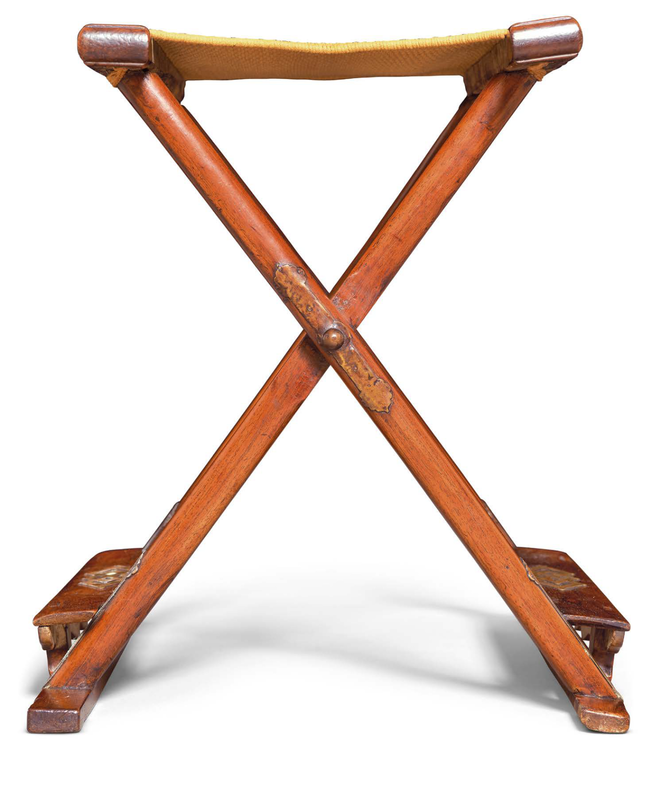A very rare huanghuali folding stool, jiaowu, Qing dynasty, 17th-18th century



Lot 3018. A very rare huanghuali folding stool, jiaowu, Qing dynasty, 17th-18th century; 22 in. (56 cm.) high, 24 in. (61 cm.) wide, 22 1/8 in. (56.3 cm.) deep. Estimate HKD 1,200,000 - HKD 1,800,000. Price realised HKD 2,250,000. © Christie's Images Ltd 2018
The stool is of elegant form with a woven seat joined by two thick members forming the upper frame, above two pairs of hinged legs of circular section joined at the mid-point with round pins and shaped hardware. The legs are braced at the front and back by footrests above cusped aprons and pairs of shaped vertical struts, all supported on wide rectangular base stretchers. The footrests are inlaid in metal with an interlocking triple lozenge and corner mounts.
Property of the Raymond Hung Collection.
Literature: R.H. Ellsworth, Chinese Furniture: One Hundred and Three Examples from the Mimi and Raymond Hung Collection, vol. 2, Hong Kong, 2005, pp. 48-49, no. 19.
Note: The unusual inclusion of footrests on both sides of the stool does not appear to be found on any other extant examples of folding stools dating to the late Ming or early Qing dynasty. Ellsworth speculates that the present stool may have been used as an ad-hoc palanquin seat. The placement of footrests on both sides would mean that the passenger or palanquin bearers would not need to turn around when coming and going. Small mortices at the bottom of the feet allowing poles or a platform to be tenoned to the stool attest to this possibility.
While rare, several similar huanghuali folding stools are known. A similar example with a single footrest at the front in the Shanghai Museum, formerly in the collection of Wang Shixiang, is illustrated by Wang Shixiang, Classic Chinese Furniture: Ming and Early Qing Dynasties, Hong Kong, 1986, pl. 31, details 1 and 2, and in Wang Shixiang, Connoisseurship of Chinese Furniture: Ming and Early Qing Dynasties, vol. II, Hong Kong, 1990, pl. A41. Another example in huanghuali is illustrated by Grace Wu Bruce in Chan Chair and Qin Bench: The Dr. S.Y. Yip Collection of Classic Chinese Furniture II, Hong Kong, 1998, pp. 76-77, no. 9, which was later sold at Christie’s New York, 20 September 2002, lot 55. A third huanghuali folding stool of this type is illustrated by Robert D. Jacobsen and Nicholas Grindley in Classical Chinese Furniture in the Minneapolis Institute of Arts, Minneapolis, 1999, pp. 36-37, no. 1.
Easily folded and carried over the shoulder, light weight, and durable, folding stools were a practical alternative for seating when travelling or hunting. A Ming-dynasty glazed figure of a servant transporting a folding stool suggests this was a commonly found form. (fig. 1). Examples are seen in a variety of woods, including prized huanghuali and zitan, but also in less expensive materials, such as jumu and tielimu. A yumu folding stool, dating to the 18th century from Shanxi, in the Kai-Yin Lo Collection, illustrated in Classical and Vernacular Chinese Furniture in the Living Environment, Yungmingtang, Hong Kong, 1998, pp. 110-111, no. 7. A tielimu folding stool formerly in the Lai Family Collection was sold at Christie’s New York, 17 September 2015, lot 931.

fig. 1. A Ming dynasty glazed figure of a servant carrying a folding stool over his shoulder. Journal of the Classical Chinese Furniture Society, Summer 1994: p. 13, fig. 15

/https%3A%2F%2Fprofilepics.canalblog.com%2Fprofilepics%2F1%2F0%2F100183.jpg)
/https%3A%2F%2Fstorage.canalblog.com%2F03%2F02%2F119589%2F96711876_o.jpg)
/https%3A%2F%2Fstorage.canalblog.com%2F11%2F31%2F119589%2F94773502_o.jpg)
/https%3A%2F%2Fstorage.canalblog.com%2F20%2F83%2F119589%2F94772815_o.jpg)
/https%3A%2F%2Fstorage.canalblog.com%2F26%2F72%2F119589%2F75604929_o.jpg)
/https%3A%2F%2Fstorage.canalblog.com%2F59%2F60%2F119589%2F26458628_o.jpg)


/http%3A%2F%2Fstorage.canalblog.com%2F89%2F67%2F119589%2F120272375_o.jpg)
/http%3A%2F%2Fstorage.canalblog.com%2F77%2F77%2F119589%2F120272063_o.jpg)
/image%2F1371349%2F20240418%2Fob_ac5c4c_telechargement.jpg)
/image%2F1371349%2F20240418%2Fob_709b64_304-1.jpg)